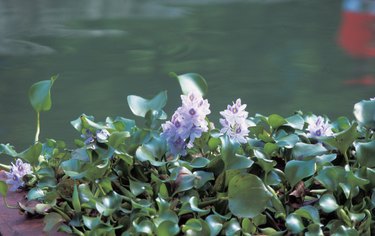
A tropical floating aquatic plant native to northern South America, the water hyacinth (Eichhornia crassipes) was introduced into the United States in the 1880s as an exotic garden plant oddity. In the southern portion of the country, where winters don't get colder than 20 degrees Fahrenheit, water hyacinths persist and grow voraciously to clog waterways and create extensive vegetative mats over lakes and ponds. If growing conditions aren't ideal, the plants become stressed and develop yellow foliage.
Plant Nutrition
Video of the Day

Water hyacinths dangle their fibrous purple and white roots into the water, absorbing necessary nutrients from the water. Lakes or ponds rich in organic matter or fertilizer runoff are rich in nutrients that promote lush, fast growth of floating plants. When the natural levels of nutrients in a body of water become depleted over time, the green coloration of water hyacinth leaves may change from deep, medium green to more yellow-green. Feces from fish and amphibians and rotting leaves and insects help replenish nutrients in the water profile.
Video of the Day
Cold Temperatures
Chilly air or water temperatures cause healthy water hyacinth plants to become stressed, often aborting leaves or stunting growth. In spring, when a gardener cleans or stocks an ornamental pond, newly purchased water hyacinths may be added for decoration. If the water is colder than 64 degrees Fahrenheit, water hyacinths will be stunted and lower, older leaves may yellow and die. Conversely, the same happens in fall with cooler water temperatures and with the onset of frost and repeated subfreezing nights.
Plants Love Sunlight
Water hyacinths appreciate warm water and lots of sunshine. The more sunshine, the warmer the water becomes. Ample sunlight, at least four hours of direct rays daily, sustains the leaves of water hyacinths but may not lead to flowers. Insufficient light levels slow plant growth and may cause leaves to yellow and prematurely die. A minimum of eight hours of sun promotes flower production.
Water Quality
Freshwater that is highly acidic or too alkaline in pH can limit the growth and vitality of water hyacinths. It may not kill the plants, but can cause yellowing leaves because the inhospitable pH levels prevent nutrient uptake by the roots. Water additives, pond liners or submerged materials may alter water pH. Residues of cleaning sprays or pesticides can lower water quality. Poison containing lead or arsenic and other heavy metals also can harm plant life as well as fish.